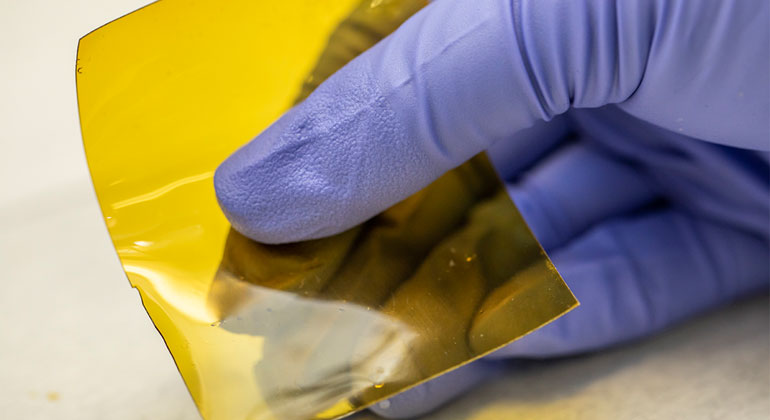Go With the Flow: Scientists Design Better Batteries for a Renewable Energy Grid
New blueprint for affordable, sustainable ‘flow batteries’ developed at Berkeley Lab could accelerate an electrical grid powered by the sun and wind.
How do you store renewable energy so it’s there when you need it, even when the sun isn’t shining or the wind isn’t blowing? Giant batteries designed for the electrical grid – called flow batteries, which store electricity in tanks of liquid electrolyte – could be the answer, but so far utilities have yet to find a cost-effective battery that can reliably power thousands of homes throughout a lifecycle of 10 to 20 years.
Now, a battery membrane technology developed by researchers at the U.S. Department of Energy’s Lawrence Berkeley National Laboratory (Berkeley Lab) may point to a solution.
As reported in the journal Joule, the researchers developed a versatile yet affordable battery membrane – from a class of polymers known as AquaPIMs. This class of polymers makes long-lasting and low-cost grid batteries possible based solely on readily available materials such as zinc, iron, and water. The team also developed a simple model showing how different battery membranes impact the lifetime of the battery, which is expected to accelerate early stage R&D for flow-battery technologies, particularly in the search for a suitable membrane for different battery chemistries.
“Our AquaPIM membrane technology is well-positioned to accelerate the path to market for flow batteries that use scalable, low-cost, water-based chemistries,” said Brett Helms, a principal investigator in the Joint Center for Energy Storage Research (JCESR) and staff scientist at Berkeley Lab’s Molecular Foundry who led the study. “By using our technology and accompanying empirical models for battery performance and lifetime, other researchers will be able to quickly evaluate the readiness of each component that goes into the battery, from the membrane to the charge-storing materials. This should save time and resources for researchers and product developers alike.”
Most grid battery chemistries have highly alkaline (or basic) electrodes – a positively charged cathode on one side, and a negatively charged anode on the other side. But current state-of-the-art membranes are designed for acidic chemistries, such as the fluorinated membranes found in fuel cells, but not for alkaline flow batteries. (In chemistry, pH is a measure of the hydrogen ion concentration of a solution. Pure water has a pH of 7 and is considered neutral. Acidic solutions have a high concentration of hydrogen ions, and are described as having a low pH, or a pH below 7. On the other hand, alkaline solutions have low concentrations of hydrogen ions and therefore have a high pH, or a pH above 7. In alkaline batteries, the pH can be as high as 14 or 15.)
Fluorinated polymer membranes are also expensive. According to Helms, they can make up 15% to 20% of the battery’s cost, which can run in the range of $300/kWh.
One way to drive down the cost of flow batteries is to eliminate the fluorinated polymer membranes altogether and come up with a high-performing yet cheaper alternative such as AquaPIMs, said Miranda Baran, a graduate student researcher in Helms’ research group and the study’s lead author. Baran is also a Ph.D. student in the Department of Chemistry at UC Berkeley.
Getting back to basics
Helms and co-authors discovered the AquaPIM technology – which stands for “aqueous-compatible polymers of intrinsic microporosity” – while developing polymer membranes for aqueous alkaline (or basic) systems as part of a collaboration with co-author Yet-Ming Chiang, a principal investigator in JCESR and Kyocera Professor of Materials Science and Engineering at the Massachusetts Institute of Technology (MIT).








